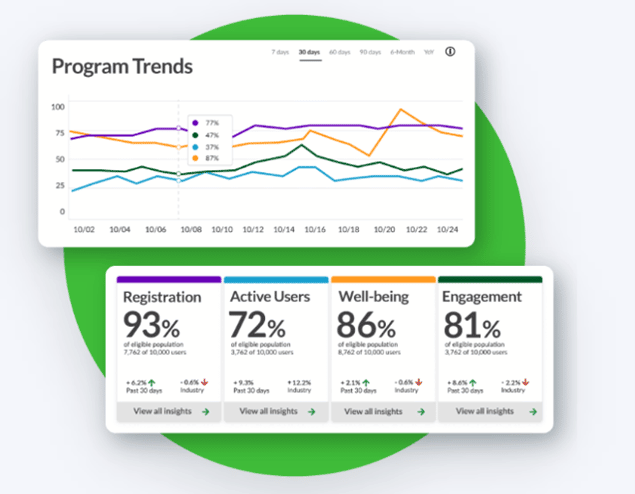The massive shifts caused by the Covid-19 pandemic have been deeply felt across all industries and at every department level within B2C and B2B companies. The effect on the global workforce has been profound, with companies around the world struggling to hire and retain employees. An evolution that many say was already in progress before the pandemic has accelerated with a balance of power starting to migrate toward employees. Companies are becoming more human-centered and human resources (HR) is shifting focus from operations and productivity toward experience, health, and wellbeing.
Stress and burnout in employees in all types of jobs has increased over the past few years. According to Gallup’s State of the Global Workplace 2022, globally, only 9% of employees consider themselves thriving and engaged, while the majority (57%) of the world’s employees are not engaged and thriving. A recent Deloitte survey found that nearly 70% C-suite employees are seriously considering quitting for a job that better supports their wellbeing.
A focus on wellbeing is no longer a nice-to-have, but a need-to-have, and has evolved beyond the historic “wellness programs” that focused things like weight loss, gym memberships, and flu shot clinics that might result in insurance premium discounts. The concept of wellbeing is a broad one and includes not just physical wellbeing, but other factors such as emotional, financial, and social wellbeing.
Technologies that can help support wellbeing vary, and Dash Research discussed this topic and different technology approaches during interviews for Dash’s upcoming report on employee experience (EX). Employee listening is strongly tied to wellbeing and culture, as any activity that allows an employee to be heard enhances their feeling of connectedness and belonging. This is the also the case with communication technologies, which can enhance connection, highlight successes, and increase transparency. However, there are other tool types that can support the development of employee wellbeing.
To improve the employee experience, Thrive Global and Genesys introduced a first-of-its-kind solution in early 2022 that enables organizations to embed wellbeing tools directly into the workflow so workers can de-stress, reset, and recharge in real time. Thrive Reset for Genesys, provides the CX industry an employer-initiated stress intervention solution for frontline workers that is science-backed and designed to focus on the root causes of burnout.
Thrive for Genesys automatically prompts a brief audio and/or video Reset – anticipating when agents need a break most – and thereby helping them lower stress in their workflow. Results from Thrive’s control pilots with the solution have demonstrated that Thrive for Genesys has increased productivity (handle time, talk time, average speed of answer, and calls per hour) while simultaneously making a material impact on agents’ wellbeing (employee satisfaction, job satisfaction, satisfaction with employer’s care for employees’ health, and wellbeing).
According to Merijn te Booij, General Manager, Workforce Engagement Management, Genesys, the application of this solution in the customer experience industry will be a particularly compelling tool. “Employee burnout is one of the most critical issues of our time, and that is especially true in contact centers where stress and attrition already run high. We partnered with Thrive to offer organizations a new way to support their employees through people-centric technology. This helps ensure workforce well-being and engagement, while ultimately leading to better customer experiences too.”
Limeade describes itself as an immersive employee wellbeing company that creates healthy employee experiences. When I caught up with Henry Albrecht, CEO of Limeade, he talked a lot about the science of care, that includes wellbeing, engagement, and inclusion. “They often say employee engagement is the engine of the company. Wellbeing is the fuel in that engine. You can’t have engagement without employee wellbeing,” according to Albrecht. “Employee Experience is a house with many doors and windows. Not everyone can own every element, but many companies are clamoring to own something and infuse it into EX. We view it all a bit differently. We don’t believe it’s about core technology infrastructure, it’s about how employees feel. We are not a transactional focused company. We are human, culture and wellbeing focused, and our goal is to have employees feel genuinely cared about.”
How does that play out in terms of technology? For Limeade, the company infuses its approach into where employees already are, with a mobile-first design that can be infused into platforms like Teams. Limeade Well-being helps send relevant and personalized resources to employees on a variety of topics. It could be information on benefits, connecting employees to the right resources at the right time, and also giving managers the support they need to help provide communication, nudges, and activities that will help improve employee connection.

“Having studied this topic for 16 years, there has never been a shortage of stress, burnout, and anxiety,” says Albrecht. “The pandemic has ratcheted it up several notches. With the move to hybrid/remote, you actually need technology to create interactions. And you have to keep in mind that technology is great, but it needs to be easy to implement and requires ongoing commitment.”
Author Information
As a detail-oriented researcher, Sherril is expert at discovering, gathering and compiling industry and market data to create clear, actionable market and competitive intelligence. With deep experience in market analysis and segmentation she is a consummate collaborator with strong communication skills adept at supporting and forming relationships with cross-functional teams in all levels of organizations.
She brings more than 20 years of experience in technology research and marketing; prior to her current role, she was a Research Analyst at Omdia, authoring market and ecosystem reports on Artificial Intelligence, Robotics, and User Interface technologies. Sherril was previously Manager of Market Research at Intrado Life and Safety, providing competitive analysis and intelligence, business development support, and analyst relations.
Sherril holds a Master of Business Administration in Marketing from University of Colorado, Boulder and a Bachelor of Arts in Psychology from Rutgers University.









